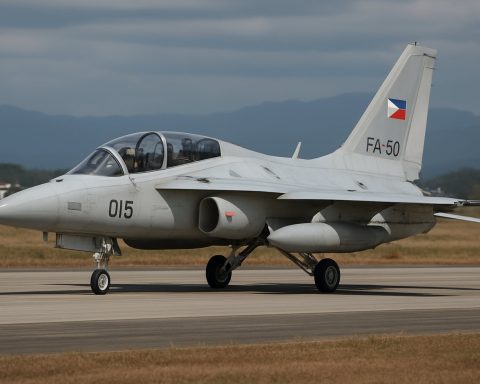- The landing of a C-17 military plane at Bagram Airbase sparks renewed speculation about US intentions in Afghanistan.
- Bagram, once a major hub for US military operations, remains significant amid geopolitical tensions involving China and the Taliban.
- The C-17’s arrival suggests potential US strategic redeployment and power projection in the region.
- Analysts ponder whether the US is preparing for regional tensions, especially with resurging extremist factions and proximity to nuclear states.
- The presence at Bagram could serve as a geopolitical outpost, aligning with US strategies in complex international relations.
- This event reiterates Afghanistan’s role in global politics, highlighting the intricate maneuvers of world powers.
A massive silhouette glided through the stark Afghan sky, leaving a trail of dust and speculation in its wake. The sight of a C-17 military plane touching down at Bagram Airbase—a location once bustling with American forces—has resurrected a myriad of questions about the United States’ intentions in a nation it once heavily occupied. This seemingly innocuous event, quietly captured by Afghan media, has ignited discussions ranging from strategic redeployment to geopolitical chess games involving regional powers like China and the Taliban’s influence.
Bagram Airbase, once the sprawling hub of US military operations, now echoes with the ghosts of missions past. The reappearance of American aircraft at this site invites a storm of conjecture about Washington’s potential strategies and interests in Afghanistan’s volatile theatre. The C-17’s arrival is more than just a logistic footnote; it’s a call for attention in a landscape marred by uncertainty.
Speculation is rife: is this a mere logistical exercise, a flash of presence to remind adversaries that the skies and fields are under watch? Some analysts suggest a broader scope at play, hinting that the US might be reasserting itself in anticipation of burgeoning regional tensions. The resurgence of extremist factions and Afghanistan’s geographical proximity to nuclear-equipped states intensifies the strategic conundrum.
Perhaps the deeper narrative lies in the subtle dance of power projection. As China expands its Belt and Road Initiative and the Taliban consolidates its grip, the airbase’s imposing presence becomes a potent symbol. A resurgent America, observers note, might use locations like Bagram not just for military purposes, but as geopolitical outposts—aligning its strategies amidst the intricate tapestry of international relations.
The return, marked by the C-17’s landing, underscores a complex reality: the US may no longer have boots on the ground in the numbers once seen, yet its shadows linger over the mountains and valleys, echoing American resilience and adaptability.
Such developments need to be seen through the prism of a broader geopolitical perspective. They starkly remind us that global interests often manifest in unexpected ways, leaving the world to ponder how nations maneuver in the shadows cast by airlifters and alliances. The key takeaway here underscores the intricacies of international politics—where every strategic move is watched, analyzed, and anticipated.
As dust settles over Bagram and eyes turn skyward, one element remains certain: Afghanistan continues to be a focal point of international intrigue and a testament to the ever-evolving dance of global powers. The subtle landing of a plane might just be the prelude to a much larger narrative.
The Mysterious Landing at Bagram: What Does It Mean for Global Geopolitics?
The surprise landing of a C-17 military aircraft at Bagram Airbase has sparked a flurry of speculation and intrigue. This event, quietly recorded by local Afghan media, raises several questions about the United States’ intentions and the broader geopolitical implications. While the landing may seem routine, the symbolism and potential strategies behind it deserve a closer examination.
Historical Context and Current Implications
A Brief History of Bagram Airbase
Bagram Airbase has long been a strategic military site, crucial during the United States’ war efforts in Afghanistan. After the U.S. withdrawal in 2021, the base shifted to a more dormant role, only sporadically visited by military aircraft. Its current use remains ambiguous, potentially signaling a strategic pivot.
US Geopolitical Interests
With recent sightings of American aircraft, analysts speculate that the United States is maintaining a strategic foothold in Afghanistan to monitor regional development. Afghanistan’s location is strategically significant, sandwiched between Iran, Central Asia, and China, making it a potential focal point for intelligence and monitoring activities.
Key Questions and Insights
Is the US Strategic Presence Resurging?
While the C-17 landing could be a mere logistical maneuver, some analysts propose a more significant move—re-establishing a minimal strategic presence to counter regional threats such as extremist factions and Chinese influence with its Belt and Road Initiative.
What About the Taliban and Regional Dynamics?
The Taliban’s grip on Afghanistan complicates matters, as any U.S. military movements are likely to provoke reactions. The power vacuum left after the U.S. withdrawal has shifted dynamics, with players like China and Pakistan taking a keen interest in what used to be American strongholds.
Emerging Trends and Forecasts
Regional Security Concerns
The volatility in Afghanistan affects the security landscape across South and Central Asia. With Taliban rule, there’s concern over the resurgence of groups that could threaten regional stability.
Economic and Strategic Opportunities
Bagram’s presence might not only serve military purposes. As China extends its Belt and Road investments, countries like the U.S. could use such bases to keep their geopolitical strategies aligned.
Practical Insights and Tips
– Stay Informed: Keeping abreast of geopolitical developments in Afghanistan is crucial for understanding broader international relations.
– Regional Focus: For businesses and investors looking at Afghanistan, it’s essential to monitor how the U.S., China, and regional players like Pakistan shape the economic and security landscape.
– Security Consultation: For NGOs and organizations operating in the region, regular security consultations are recommended to navigate the changing dynamics effectively.
Conclusion
The dust swirling at Bagram Airbase might symbolize more than just a plane landing—it could be a prelude to larger geopolitical shifts. Observers need to watch these developments closely, as the movements at such strategic points often illuminate broader geopolitical narratives.
For more on strategic and geopolitical analyses, visit CNN or explore current affairs at BBC News.







